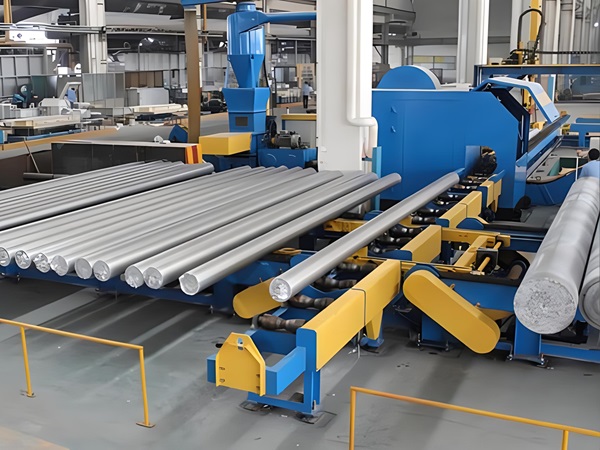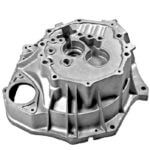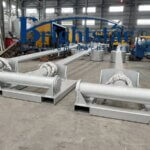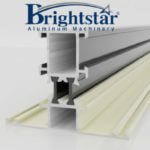Why do aluminum chips appear powdery when sawing aluminum billets?
Why do aluminum chips appear powdery when sawing aluminum billets?
There are several reasons why aluminum chips might appear powdery when sawing aluminum billets in aluminum billet saw for cutting aluminum log:
1. Friction and Heat:
Sawing generates friction and heat.
As the saw blade rubs against the billet, the aluminum heats up and softens.
This softened aluminum can shear off in smaller, flake-like pieces rather than larger, continuous chips.
These thin flakes, especially when combined with oxidation from the heat, can create a powdery appearance.
2. Aluminum Properties:
Aluminum is a relatively soft metal compared to materials like steel.
This softness makes it more prone to tearing and shear during sawing, rather than forming clean, defined chips.
Additionally, aluminum readily forms thin oxide layers on its surface.
These oxide layers can flake off during sawing, adding to the powdery texture.
3. Saw Blade Type and Use:
The type and condition of the saw blade can also affect the chip formation.
Dull or worn blades can generate more heat and friction, contributing to a powdery texture. Using blades specifically designed for cutting aluminum can help improve chip quality.
4. Lubrication:
Lubrication is crucial for reducing friction and heat during sawing.
Using appropriate lubricants can help minimize the formation of powdery chips and improve the overall cutting process.
5. Casting Defects:
In some cases, the powdery appearance might not be entirely due to the sawing process.
If the aluminum billet has internal defects or inconsistencies from the casting process, these can break off during sawing and contribute to the powder.
Additional factors:
The sawing speed, feed rate, and coolant also play a role in chip formation.
Optimizing these parameters can help improve chip quality and reduce the amount of powder.
By considering these factors and optimizing the sawing process, you can minimize the formation of powdery aluminum chips and improve the overall cutting efficiency.
There are a few key reasons why aluminum chips might appear powdery when sawing aluminum billets in an aluminum billet saw for cutting aluminum log, beyond the general points already mentioned:
1. Ductility and Shear Deformation:
Aluminum is highly ductile, meaning it readily deforms under pressure.
During sawing, the saw blade applies pressure, causing the aluminum to shear off in a layer-like fashion rather than breaking off in larger, defined chips.
These thin layers create the “powdery” appearance.
2. Strain Hardening and Localized Melting:
The continuous shearing during sawing can work-harden the aluminum locally, making it stiffer.
This hardened material then fractures into smaller pieces, contributing to the powder.
Additionally, the concentrated friction and heat can cause localized melting at the cutting point, leading to liquid aluminum solidifying into fine particles.
3. Oxide Layer Adhesion:
As you mentioned, aluminum readily forms an oxide layer on its surface.
This oxide layer can have varying degrees of adhesion to the underlying aluminum.
Weak adhesion can lead to the oxide layer flaking off with the chips, further contributing to the powdery texture.
4. Saw Blade Geometry and Wear:
The geometry of the saw blade teeth significantly impacts chip formation.
Teeth with a smaller rake angle (angle between the cutting face and the direction of motion) tend to generate smaller chips closer to powder due to increased shearing.
Additionally, a worn-out blade can have blunt teeth, further exacerbating the powdery chip issue.
5. Sawing Parameters:
As briefly mentioned before, sawing parameters like speed, feed rate, and coolant play a crucial role in chip formation.
High feed rates can lead to thicker chips, while excessive speed can generate more heat and promote powdery chips.
Coolant selection and application are also important, as proper cooling reduces friction and minimizes thermal softening, leading to more defined chips.
Additional factors:
The presence of impurities in the aluminum billet can act as stress concentration points, leading to localized fractures and contributing to the powder.
Grain size and microstructure of the aluminum can also influence chip formation, with finer grains generally leading to smaller chips.
Remember, the specific cause of powdery chips in your case might depend on various factors unique to your sawing process and material.
Optimizing these factors based on the specific reasons identified can help improve chip quality and minimize the powdery appearance.
Brightstar Aluminum Machinery offers aluminum billet saw for cutting aluminum logs, turnkey project and package deal.










